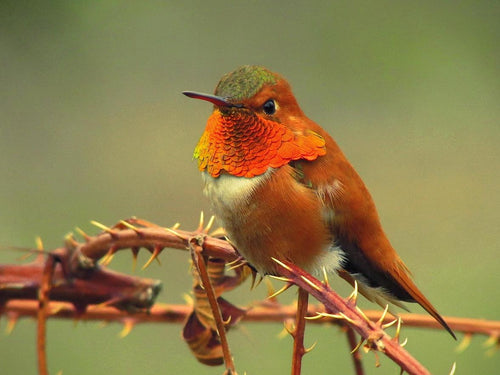Vibrant World of Colorful Hummingbirds: Exploring Their Dazzling Colors
TTNatureTeam
When a small figure shimmering with a bluish-green metallic luster darts past you, you might think you've seen a flying gem—this is the magic that colorful hummingbirds bring to the world.
The feathers of hummingbirds are particularly vibrant, so finely crafted that they resemble sculptures, but in the world of hummingbirds, feathers are not mere decorations; they are a language of survival evolved over thousands of years.

This article will take you on a journey to explore the story behind colorful hummingbirds and how to protect these little sprites of the bird world.
The Colors of Hummingbirds and Their Gemstone Representations
Different species of hummingbirds display various colors while flying, shining like gemstones. Because of this, among the more than 300 species of hummingbirds worldwide, over 50 have been given names related to gemstones.
- Azurite: Azure-crowned Hummingbird
- Amethyst: Amethyst-throated Mountain-gem
- Sapphire: Great Sapphirewing
- Beryl: Berylline Hummingbird
- Ruby: Brazilian Ruby
- Emerald: Canivet's Emerald
- Tourmaline: Tourmaline Sunangel
- Garnet: Garnet-throated Hummingbird
- Topaz: Ruby-topaz Hummingbird
- ......
Currently, there are more than a dozen species of hummingbirds that can be seen in the United States, including Allen's Hummingbird, Rufous Hummingbird, Anna's Hummingbird, and Ruby-throated Hummingbird.
Although they only represent a small portion of the entire hummingbird family, people can still find many colors among them.
Why are hummingbird feathers colorful?
Take Anna's Hummingbird as an example; at first glance, it appears green and grey, but when it twists its head, you will be pleasantly surprised to find that its feathers turn bright pink.

This is because the colors of these hummingbird feathers are unique, known as structural colors. The principle behind structural colors is based on a simple physical phenomenon—light refraction and interference.
When sunlight shines on the hummingbird, the feathers on its neck reflect light at different angles, creating a variety of dazzling colors.
Therefore, the feathers of hummingbirds do not change color; rather, the colors we see change with the angle of observation. Even the same feather can display different colors when viewed from different angles.
In addition to structural coloration, hummingbirds also exhibit colors influenced by pigments, such as browns and blacks, which are not affected by light.
The Language of Hummingbird Colors
Mating and Reproduction
The feathers of male hummingbirds transform into a dynamic display during courtship; the brighter and more dazzling the colors, the better they showcase the male hummingbird's strong and healthy physical condition. This magical color-changing ability is key to the successful mating of hummingbirds.
It is noteworthy that the vibrant colors are often possessed only by male hummingbirds. Female hummingbirds do not have such rich colors.
Camouflage and Survival
Some hummingbirds use their colors to blend into their surroundings, making it difficult for predators to spot them. With the clever camouflage of their feathers, hummingbirds can improve their survival rate in the wild to some extent.
Five Stunning Colorful Hummingbirds
Ruby-throated Hummingbird

Photo by ShenandoahNPS
Male Ruby-throated Hummingbirds have throats that display a bright metallic ruby color. This gorget can appear to change from a deep, almost black hue to a fiery red depending on the light and viewing angle. During courtship displays, males will rapidly move to showcase this color shift. Female hummingbirds have green backs, with throats that are clear white or light gray.
Violet-crowned Hummingbird

Photo by Wendy R Fredericks
It is named for its unique purple-blue crown. The feathers on the top of its head have a special structure that can reflect ultraviolet light, creating an "invisible crown" that is not visible to humans but can be seen by birds. Its throat and chest are pure white, while its back is green.
Rufous-tailed Hummingbird

Photo by Lip Kee
The Rufous-tailed Hummingbird is instantly recognizable by its warm reddish-brown tail. Adult male Rufous-tailed Hummingbirds typically have a rufous (rusty reddish-brown) back and flanks, and a bright orange-red throat. Their tail feathers may show some iridescence in the light.
Blue-throated Hummingbird

Photo by Falco Beutler
The male hummingbird has a large and unique sapphire-blue throat patch. Their backs are bronze-green, while their bellies are a deeper gray.
Fiery-throated Hummingbird

Photo by rolf.riethof
The male boasts an astonishing rainbow-colored neck, changing from purple to orange-red in the same spot. The underside is fiery orange, gradually transitioning to yellow, green, and blue, all the way to the beak.
Prepare a hummingbird feeder
If you want to observe these marvelous natural colors up close, a smart hummingbird feeder is a great choice. You can provide suitable food and resting places for the hummingbirds while sitting on the sofa and enjoying the vibrant colors and aerial performances of these little sprites.

Conclusion
The dazzling colors of hummingbirds are not merely decoration but are a result of their continuous evolution throughout history.
Watching a hummingbird hover in front of a honeysuckle, the sunlight flowing over the feathers on its throat—from deep black to bright purple and then to a dazzling metallic blue.
The most exquisite colors in nature are not ostentatiously displayed in a gallery, but are hidden within the tiny life that vibrates 80 times per second, shimmering for just a moment for those who are willing to pause. This is all its magic.




